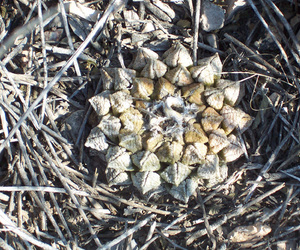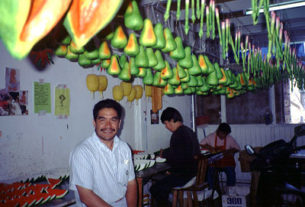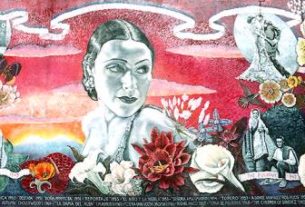Mexican History
The Fiesta de las Plantas Medicinales is held every year in a different pueblo in Mexico. This three day event features workshops given by curanderos (native healers), herbalists, and other native specialists in various traditional practices and beliefs involving alternative or traditional medicine.
In March of 1990, I gave a lecture at the Unitarian Society in Guadalajara entitled “World of the Huichols,” based mainly on my academic researches of Huichol religion and world view. Judging from the compliments I received afterwards, I would say my talk must have gone very well, although I felt a little uncomfortable realizing that some people in my audience had more actual experience with the Huichol people than I had.

© 2008, Jeffrey R. Bacon.
This began to change in September of that same year when I attended the Fiesta of Medicinal Plants at Atotonilco El Alto, Jalisco. I had read in the Fiesta brochure that there was to be a workshop on Traditional Huichol Medicine conducted by a genuine mara’akame (shaman-priest) from the remote sierras. I resolved to attend.
I arrived too late for the opening ceremony but managed to sign up for the first workshop on Huichol medical practices. However instead of a Huichol, we were greeted by Jesús Higuera from Ajijic, who was to conduct the workshop.
At least he did look like a Huichol with his dark complexion, shock of black hair, sparse straggling black beard, and piercing black eyes. He wore an amulet around his neck and carried the usual embroidered Huichol side bag. Katuza, as he preferred to be called, mumbled something to the effect that the Huichol shaman didn’t come because he thought the members of the group were not sufficiently prepared spiritually. This did not sound particularly convincing.
However, Katuza took over and spent the first few hours explaining the basic deer-maize-peyote complex of Huichol religion and the importance of Dios Hikuri (the Peyote God) to the Huichols. We learned that, in fact, the Huichols really did not have much in the way of traditional medicine but instead used magical means to treat and even cure certain illnesses.
The shaman cures by working on the mind of the patient using the muwieries (magical arrows), wafting of hands over the patient, and removing particles representing the disease from the patient’s body. But the main force in Huichol curing practices was (and still is) the hallucinogenic cactus, the peyote.
Much of what I heard confirmed what I had already learned from Lumholtz, Zing and other early writers on the Huichol. We were then given a kind of psychological explanation of Huichol religious beliefs and medical practices and a demonstration of massage techniques from Katuza, who was also a professional masseur. But this was not what I had come to see and hear.
The next morning we went on a field trip into the mountains near the town in search of medicinal plants. Herbal plants and their uses in traditional medicine was one of the main themes of the fiesta. But the announced Huichol workshop was still in disarray. The field trip seemed to be a substitute for the workshop. We didn’t have far to go to discover a few medicinal herbs but, after a few half-hearted attempts at searching, we were led into a secluded nook on a hillside surrounded by trees and dense bushes.
There was just enough bare ground and rocks for us all to sit down. Katuza then took over as leader of the group explaining once again that the Huichol shaman did not come with us because we were not properly prepared spiritually. This did not really make sense to me because we were presumably out on an herb gathering expedition, not on the pilgrimage to Wirikuta in search of peyote for the annual Peyote Fiesta in June.
Katuza then conducted a private peyote ceremony of his own right there on the hillside.
He built a small brushwood fire and we all sat around in a circle as he explained the Huichol confessional ceremony. During the annual journey to Wirikuta, the sacred desert area near San Luis Potosí, the Huichols publicly confess their sins as part of their purification before searching for the peyote. By way of imitation we wove little vines into knots, each signifying our private misdeeds, which we then threw into the fire thereby symbolically burning up all our sins to date.
We were all requested to take off our shoes as a sign of respect.
Katuza then produced a large peyote bud from his pouch, which he treated with great respect, explaining that the peyote is like a god to the Huichol. He rubbed both wrists with the peyote, touched it to his bowed forehead, and prayed to “Father Sun, Mother Earth, the Creator.” Biting off a chunk of the raw peyote, Katuza chewed it very slowly, head bowed, as he passed the peyote around the circle. Everyone took a bite and passed it on. We then joined hands and one by one each person was called upon to “confess” how he or she felt about the experience. Some participants were quite emotional about the whole thing. All I could say was that I found the experience most interesting and I was prepared to learn more.
I confessed privately to myself that I did feel a strong bond of attachment within the enclosed circle — at least temporarily. Certainly the closeness of the circle in a hidden grove on a secluded hillside, the holding of hands and public confession, the significance of the peyote to the Huichol, and the obvious sincerity of our leader, Katuza, produced a strong emotion of sharing a very special, very private, and yet public ceremony with others of like feeling. For a few moments total strangers were bonded together as one. As the “objective” observer, I too was drawn into “subjective” participation in a mutual religious or spiritual experience.
After the ceremony we filed back down the hillside to the fiesta grounds. We did not collect any herbs nor did we discuss the ceremony or talk about herbs in the workshop. Most of the time was spent in demonstrations of various massage techniques. I was still wondering what had happened to the promised Huichols.
The next morning, the previously announced workshop on “Traditional Huichol Medicine” was postponed once again. Instead we were introduced to a ritual singer or chanter, who told us to form a circle and try to follow him. The chant consisted of short syllables repeated over and over again. Surprisingly, we soon found ourselves making a pretty good imitation of the chanter. Then an older man, rather stout, with a short beard and wearing a headband, entered and was introduced to us with great respect as the Tlacaelel (the name of Moctezuma’s advisor who initiated the concept of xochiyaoyotl, the “Flowery Wars” in ancient Aztec society). He had a kindly, almost fatherly expression on his face as he instructed us to relax by letting our arms dangle and our bodies go lax. We were told to close our eyes and shut out the outside world as much as possible.
The chanter began to sing some very high-pitched songs or chants in a strange language. The rise and fall of his voice produced a highly dramatic effect. I wasn’t sure what I was supposed to do, so I ventured to open my eyes. Everyone else in the circle had their eyes tightly closed. I glanced towards the Tlacaelel and found myself staring into his wide bright eyes. Quickly I closed my eyes and kept them that way for the rest of the session, although I did notice the strikingly sharp visage of the singer with his staring eyes that seemed to be probing empty space.
The soft voice of the Tlacaelel could be heard during short breaks in the chanting. He told us to observe the bright lights (with our eyes closed of course), the points of yellow, and other things he described. We were told that our bodies were becoming transparent, very light. Although I was concentrating on the proceedings with a view to writing it all down later, I must confess I did feel the power of suggestion, the collective force of group participation, when all the members are drawn closely together in a common bond.
Finally the chanting ended and we were told to open our eyes on the count of three. Indeed it did take a little time to return from the dream world of mystical chanting and hypnotic suggestion. Or was there more to it than that? One woman did have considerable trouble opening her eyes again.
The Tlacaelel then called for testimonials from the group. One woman said she had seen the points of light, another that she had experienced the transparency of body described by the shaman. He smiled with benign satisfaction at every confirmation of his spiritual powers. And indeed he did resemble a kind of saintly Indian priest.
The Fiesta ended with the Dance of the Conquest by the “Ximachtli” (“Semilla de Legumbres,” Vegetable Seed) dancers, who wore huge feather headdresses, brightly coloured capes, and shell rattles around their ankles. The dancers formed a large circle around the huehuetl drummer, who kept up a steady beat, punctuated with subtly changing rhythms, throughout the entire ceremony. Whirling about, the dancers kicked out their legs in a wild and yet controlled series of gyrations. Some then set up an altar of incense in front of the drummer. One female dancer swung an incense burner which gave off a very strong odour even from a distance in this outdoor setting.
Earlier at the hotel I had met a young couple with a little girl who, I presumed, had come to the Fiesta as spectators. Imagine my surprise when I saw them standing at the edge of the dance circle as the incense-bearer purified them with the smoke of the incense. It was a baptismal ceremony in the ancient style!
The young couple and the child were led in front of the high priest with his towering feather headdress of long ostrich plumes and silver mask on his forehead. He addressed the parents, while the incense-bearer stood close by. Then another female dancer, possibly a symbolic midwife, took the now screaming child and lifted her up in turn to the Four Directions and prayed, while the incense smoke almost enveloped them entirely. The couple then returned to the edge of the dance circle, where they were once again ritually purified with incense. The entire scene could have come out of Book Six, pages 202-203 of Sahagun’s Florentine Codex describing the offering of an Aztec child to the heavens.
When the ceremony was over my mother and I took pictures of the couple and their child. The mother asked me what I thought of the ceremony. I replied, quite honestly, that it had been most touching, a very emotional experience for all concerned. She said she felt very nervous but was reassured that the child had cried in response to her own emotional reaction.
Tourist are welcome at traditional fiestas like this but sometimes fail to realize that these ceremonies are the real thing; they are not intended as tourist attractions.
Rumours are also rife at these big fiestas and it soon became apparent why the Huichol workshop had been cancelled. The word spread that the Mexican federal police were lurking around the fiesta grounds searching for illegal drugs among the numerous medicinal herbs on display.
Consequently the Huichols refused to hold a workshop for fear of sacrilegious interference with Dios Hikuri, the Peyote God, by the federales. They feared, too, that the authorities might accuse them of making peyote available to the participants. It was for this reason Katuza decided to hold his own private peyote ceremony in the hills, an action for which he was later criticized.
Pre-Columbian religion and traditions are not dead in Mexico.
Part 2 of a seven part series
- Personal reminiscences of Mexico’s Huichol people I: a disappearing way of life?
- Personal reminiscences of Mexico’s Huichol people II: fiesta of medicinal plants
- Personal reminiscences of Mexico’s Huichol people III: the shaman
- Personal reminiscences of Mexico’s Huichol people IV: ritual dance
- Personal reminiscences of Mexico’s Huichol people V: journey to the sierra
- Personal reminiscences of Mexico’s Huichol people VI: Peyote Fiesta
- Personal reminiscences of Mexico’s Huichol people VII: return from the Huichol sierra


